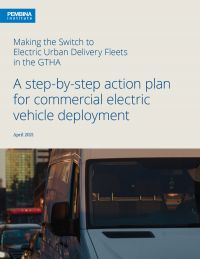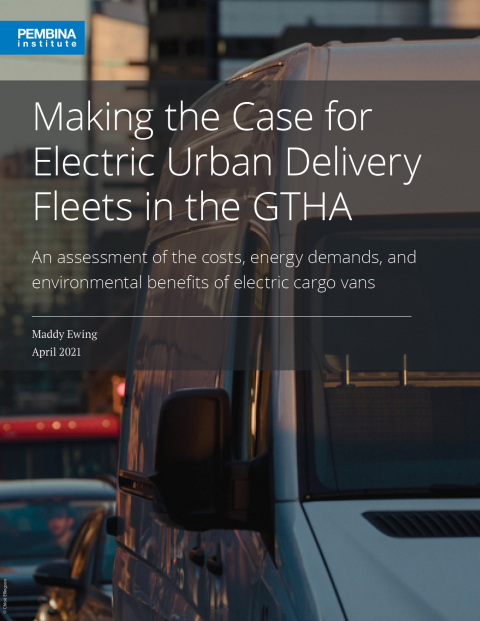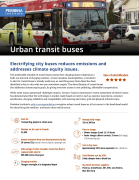With the publication of two new reports, Making the Case for Electric Urban Delivery Fleets in the GTHA and Making the Switch to Electric Urban Delivery Fleets in the GTHA, the Pembina Institute provides urban delivery couriers with the knowledge to better understand the considerations involved in switching to electric delivery vehicles.
As door-to-door deliveries increase in Canadian cities, a switch to electric vehicles is an important way that businesses, fleet operators and city planners can mitigate the impact of urban delivery emissions on climate change and air quality.
In Canadian cities, where transportation-related greenhouse gas (GHG) emissions often account for a high portion of all emissions, battery-electric vehicles (EVs) are expected to offer significant GHG emission reductions in comparison to internal combustion engine vehicles. Moreover, EVs do not produce tailpipe emissions and thus do not contribute significantly to the degradation of local air quality.
But the reality is that although this zero-emission technology exists today and there are examples of electric delivery vans operating in some global and Canadian cities, the deployment of fully electric delivery vans in Canada is still in its infancy.
Switching to fully electric vehicles is complex and requires businesses and fleets to have a comprehensive understanding of existing and future operational needs, infrastructure, and energy demands, along with the costs associated with transitioning to a new transportation and energy system.
Assessing the costs and benefits of EVs
To help businesses understand the costs and benefits of operating battery-powered electric urban delivery vehicles, analysis published in Making the Case for Electric Urban Delivery Fleets in the GTHA sets out to uncover the expected costs, energy demands and GHG emission savings associated with a switch to electric cargo vans, specifically in the Greater Toronto and Hamilton Area (GTHA).
The modelling exercise demonstrates that fleet operators delivering parcels and packages in the GTHA can realize notable economic and environmental benefits as a result of switching to an EV. Similar results can be expected in other cities, too. More specifically, the analysis finds:
- All electric cargo van models currently available on the market today, as well as new models under production, are expected to satisfy the daily energy demands of urban delivery companies in the GTHA — even under the most energy-demanding scenario that was explored.
- EVs can charge overnight using Level 1 or Level 2 charging across all of the scenarios that were explored, meaning that businesses may not be required to invest in direct current fast charging infrastructure, which can significantly increase their capital costs.
- EVs are expected to result in considerable fuel cost savings in comparison to ICEVs. Over the course of a year, businesses can expect to save an average of $3,800 to $4,400 per vehicle for Level 1 and Level 2 charging, respectively. (These cost savings do not reflect the impact of carbon pricing, which provides further incentive to switch to EVs.)
- The higher upfront capital costs of an EV compared to an ICEV are expected to be recovered by annual cost savings in approximately seven to eight years. This payback period is reasonable as it falls within the typical vehicle ownership cycle of the businesses that participated in this study.
- EVs offer substantial GHG emission savings in comparison to ICEVs. On average, an annual reduction of 12 tonnes CO2e per vehicle is expected. This is equivalent to taking 2.6 passenger cars off the road for one year.
Steps to help make the switch
 Considering the strong case for a shift to electric delivery vehicles, businesses across Canada are already making commitments to reduce their environmental footprint by transforming their vehicle fleet and infrastructure. From national courier companies with vehicles operating in cities to small local companies with a handful of cargo vans, all urban delivery fleets should consider making the switch, regardless of size.
Considering the strong case for a shift to electric delivery vehicles, businesses across Canada are already making commitments to reduce their environmental footprint by transforming their vehicle fleet and infrastructure. From national courier companies with vehicles operating in cities to small local companies with a handful of cargo vans, all urban delivery fleets should consider making the switch, regardless of size.
However, integrating a new transportation and energy system is complex. Experience and lessons learned from early adopters show that the planning process for deployment is extremely important and should not be underestimated.
Policies at a federal, provincial and municipal level are needed to help incentivize the switch to EVs, but in the interim, to help commercial fleets get started, Making the Switch to Electric Urban Delivery Fleets in the GTHA provides a step-by-step guide and key tips to deploy battery-electric urban delivery vehicles (medium-duty, class 2b-3) with on-site depot charging. The steps are specifically targeted to fleets in the GTHA, however companies operating in other regions in Canada may find many of the steps applicable.
These steps include:
- identifying suitable electric vehicle models;
- creating a phasing plan that incorporates a trial or pilot period;
- assessing facility and site infrastructure requirements;
- identifying the ideal ratio of chargers to vehicles;
- selecting the preferred financing or leasing model;
- training maintenance staff; and more.
Note: Making the Switch to Electric Urban Delivery Fleets in the GTHA was updated June 2021 to include information on the proposed federal Clean Fuel Regulation.








